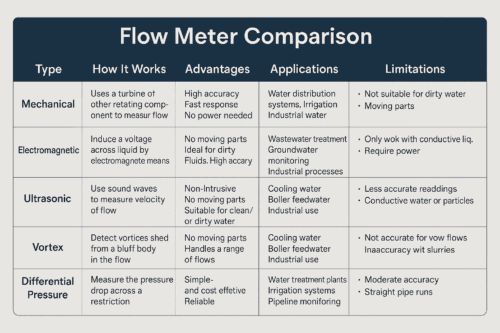Water flow measurement is essential across many industries — from municipal water supply and wastewater treatment to agriculture, manufacturing, and environmental monitoring. Selecting the right flow meter depends on several factors: the accuracy required, pipe size, flow range, budget, and the condition of the water (clean, dirty, pressurized, etc.). In this blog post, we’ll explore the most common methods used to measure water flow with a flow meter and the technologies behind them.
Why Flow Measurement Matters
Before diving into the specific types of flow meters, it’s important to understand why accurate water measurement is so critical. Flow meters help:
- Monitor water usage and reduce waste
- Control chemical dosing
- Ensure regulatory compliance
- Maintain equipment efficiency
- Improve process control and automation
Categories of Flow Meters for Water
There are several types of flow meters used to measure water. These can generally be categorized into volumetric flow meters and velocity-based flow meters.
1. Mechanical Flow Meters
Turbine Flow Meters
Turbine flow meters operate by placing a spinning rotor in the path of the fluid. As water flows through the meter, it causes the rotor to spin. The rotational speed of the rotor is proportional to the water’s velocity and, in turn, its flow rate.
Advantages:
- High accuracy (±0.5% typical)
- Suitable for clean, pressurized water
- Fast response time
Applications:
- Water distribution systems
- Irrigation
- Industrial water management
Positive Displacement (PD) Meters
PD meters physically capture a known volume of water in compartments, then count how many times those compartments are filled and emptied.
Advantages:
- Very high accuracy at low flow rates
- No need for external power
- Suitable for viscous fluids
Applications:
- Residential and commercial water metering
- Batching applications
Limitations:
- Not suitable for dirty or debris-filled water
- Can wear out faster due to moving parts
2. Electromagnetic (Mag) Flow Meters
How They Work
Mag meters use Faraday’s law of electromagnetic induction. As water (a conductive fluid) flows through a magnetic field inside the meter, it generates a voltage proportional to the flow velocity. Electrodes capture this voltage and convert it to a flow rate.
Advantages:
- No moving parts (low maintenance)
- Ideal for dirty or raw water
- Highly accurate (±0.2–1%)
Applications:
- Wastewater treatment
- Groundwater monitoring
- Industrial processes
Limitations:
- Only works with conductive liquids (not pure distilled water or oils)
- Requires external power
3. Ultrasonic Flow Meters
Ultrasonic flow meters use sound waves to measure the velocity of water. There are two main types:
Transit-Time Ultrasonic Meters
These meters send ultrasonic pulses both upstream and downstream. The difference in time it takes for the signals to travel correlates with the water’s velocity.
Advantages:
- Non-intrusive (clamp-on options available)
- No moving parts
- Accurate for clean water
Applications:
- Municipal water systems
- HVAC systems
- Water distribution networks
Doppler Ultrasonic Meters
These meters send sound waves into the water and detect the shift in frequency as they bounce off suspended particles or bubbles.
Advantages:
- Works with dirty or aerated water
- Non-invasive clamp-on options
Applications:
- Stormwater runoff
- Slurry lines
- Industrial wastewater
Limitations:
- Requires particulates or bubbles in the flow
- Less accurate than transit-time meters
4. Vortex Flow Meters
How They Work
Vortex meters place a bluff body (obstruction) in the water’s path. As the water flows past, it creates swirling vortices. The frequency of these vortices is directly proportional to the flow rate.
Advantages:
- No moving parts
- Good for a wide range of flow rates
- Works with both clean and slightly dirty water
Applications:
- Cooling water in power plants
- Boiler feedwater
- General industrial use
Limitations:
- Not ideal for very low flow rates
- Can struggle with slurries or very dirty fluids
5. Differential Pressure (DP) Flow Meters
DP meters measure the pressure drop across a restriction in the pipe (like an orifice plate, Venturi tube, or flow nozzle) and use this difference to calculate flow rate.
Orifice Plate Meters
These are flat plates with a hole in the center. As water flows through the hole, the change in pressure before and after the plate reveals the flow rate.
Venturi Meters
Venturi meters use a tapered constriction to minimize energy loss while still producing a measurable pressure drop.
Advantages:
- Simple and cost-effective
- No moving parts
- Reliable for pressurized systems
Applications:
- Water treatment plants
- Irrigation systems
- Pipeline monitoring
Limitations:
- Moderate accuracy
- Requires long straight pipe sections for accuracy
Choosing the Right Flow Meter for Your Water Application
With so many technologies available, how do you choose the right flow meter for your application? Here are a few key considerations:
Type of Water
- Clean water: Turbine, ultrasonic, mag meters
- Dirty water or wastewater: Mag, Doppler ultrasonic, vortex
- Low flow or residential use: Positive displacement
Installation Environment
- Clamp-on needed: Ultrasonic
- Inline, permanent installation: Mag, turbine, vortex, PD
Budget
- Low-cost options: Mechanical meters (turbine, PD)
- Higher upfront cost, low maintenance: Mag and ultrasonic meters
Accuracy Requirements
- High precision needed: Electromagnetic, transit-time ultrasonic, turbine
- Moderate precision acceptable: Vortex, DP meters
Conclusion
There’s no one-size-fits-all solution for measuring water flow. Each type of flow meter has its own strengths and ideal use cases. Whether you’re managing a municipal water supply, running an industrial process, or monitoring environmental water flows, understanding the different technologies can help you choose the most efficient, cost-effective, and reliable option for your needs.
